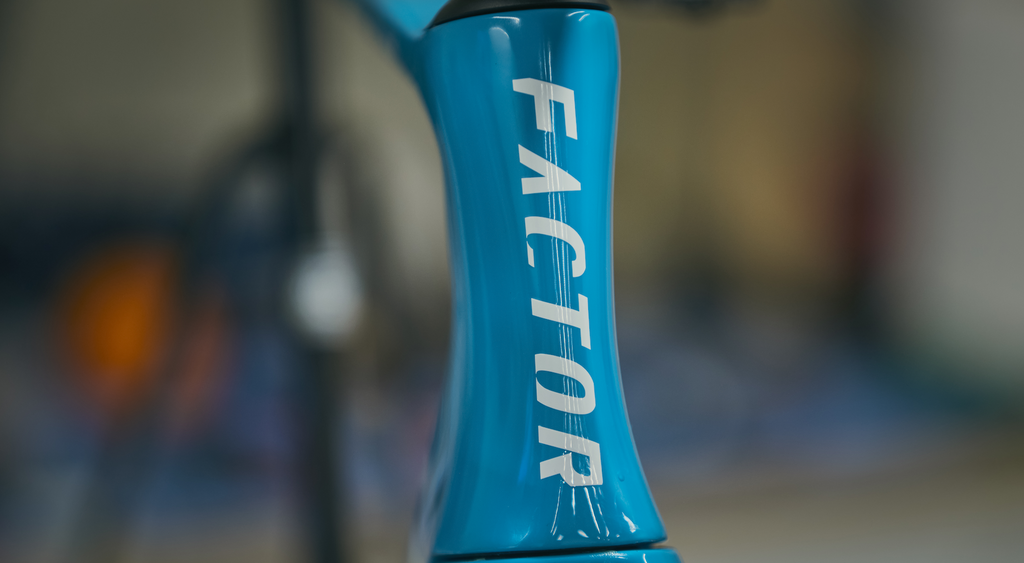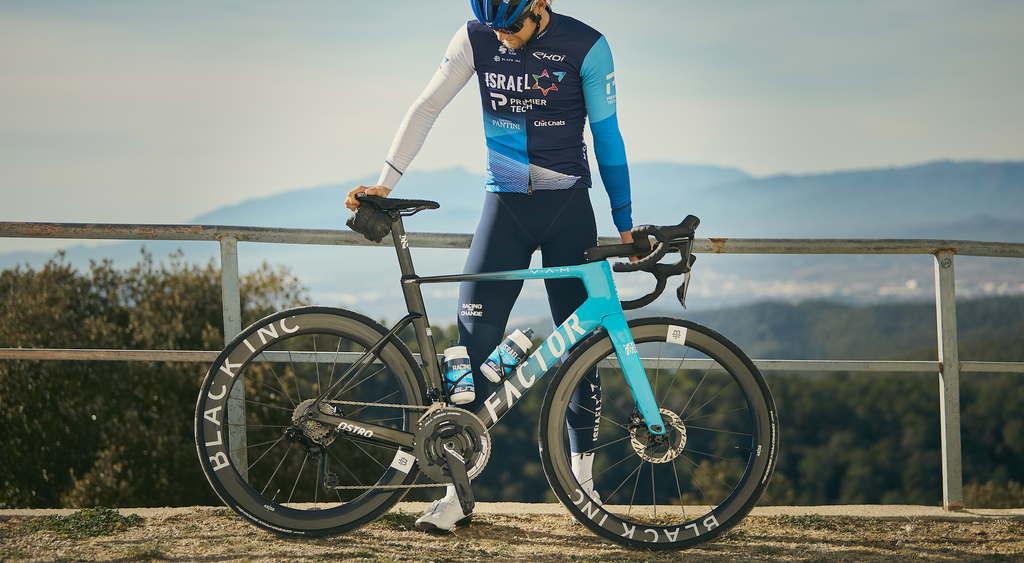New Factor Ostro VAM: narrower, smoother, faster… and the WorldTour’s cleverest bottle cages
Simon Smythe takes a first look at Factor's latest update to its do-everything road bike
The new Factor Ostro VAM made a dream debut in the WorldTour, winning the Tour Down Under at the end of January with Israel-Premier Tech’s Stevie Williams. If it had been hiding in plain sight before, that was no longer possible once the Welshman sprinted to victory at the top of Mount Lofty.
Rachel Jary got a good look at Williams’s bike at the time – now Factor has released all the details and the data.
As the aero all-rounder in the range (the O2 VAM is the lightweight climber), the emphasis was, according to Factor founder Rob Gitelis, simply on how to make the original Ostro VAM more aerodynamic: “It was already very light, it was already very stiff – it was about how to make it faster but stay true to the Ostro heritage… and make something great even better. Or, in the words of the press release: “We wanted the soul of the Ostro VAM completely preserved, only this time faster.”
Spoiler alert – the second-generation Ostro VAM is just over 10% – or seven watts – faster. And despite shedding weight not being a declared goal, according to Factor the frame ended up a claimed 10g lighter at 820g for the size 54 (the new Ostro VAM has the same geometry as before) – a “byproduct” of its development.
Looking at the startlingly narrow tube profiles – the seat tube is just 19.5mm wide while front-on the seatpost at 15mm almost disappears – it’s not surprising.
As Factor’s engineering director Graham Shrive explains, it’s the relaxation of the UCI’s rules limiting tubing and component dimensions that drove the brand to redevelop and improve the original Ostro VAM, launched in 2020. “The removal of the 3:1 rule for components about two years ago as well as the ability to reduce tube cross-sections below 25mm in the main tubes was something we were able to manipulate – and you can already see it in practice in our new O2.”

As well as the chance to make deep tubes very narrow, there were more changes that allowed Shrive and his team to “debottleneck” – the engineering term for identifying what’s holding back a process and improving it. For example: “The move to wireless Shimano Di2 has given us the chance to really objectively look at where we want to hide the battery,” he says. (This is great timing, since a Di2 battery will struggle to fit into a seatpost 15mm wide.) Additionally: “For us the seatpost clamp of the old bike wasn’t well loved and was a struggle from a manufacturing point of view so that was an easy place to improve.” And more generally, for the overall redesign: “We’ve also been able to use the new CFD development techniques developed in the last three or four years.”
Zoning in
Using digital CFD tools, Shrive and his team’s approach was to break the bike down into discrete areas, starting with the leading edge – the fork and the head tube which, says Factor, have the largest impact on flow behaviour. “The front of the bike is where we get the biggest opportunity to influence the drag on the rider and the bike as a whole,” explains Shrive.
“For example, the fork is separate from the bike but also the airflow on the fork is quite different. At the front of the bike we have what’s called freestream airflow, which hasn’t been fouled by the rider or spinning wheels. As you move further back that airflow becomes more and more disrupted.”
Shrive says Factor even broke the fork down into separate areas. “How does the airflow change up and down the fork as well as front to back? The airflow with a rotating wheel is quite different at the brake rotor and hub area than it is at the mid chord section as well as up by the tyre. We looked at the fork in context of improvement with the rider as well as just the bike and just the fork.”
Visually, the head tube is much more slender than the previous Ostro VAM’s, with a waisted hourglass profile that presents a lower frontal area, while the fork crown is lower. The transition area between the fork and the down tube is smoother than before, as are all the areas of the frame where one tube joins another.

“You don’t want a big step by the dust cover or the spacers to the bar,” points out Shrive. “In our case we’ve made custom spacers: kept a 20mm spacer as well as 5 and 10mm spacers so you can get a really nice shape even with as much as 35mm of spacers.”
And the top tube obviously tapers more than before along its length as it meets the narrower seat tube.
Bottle trick
Often there’s some little trick that an engineer is particularly proud of, no matter how marginal the gain, and with the new Ostro VAM it’s the effect of a specially designed seat tube bottle cage on the airflow over the rear wheel once a rider has thrown out the bottle in preparation for the sprint.
“UCI rules have become more explicit around fairing and bottle cages,” says Shrive. “As an engineer, whenever you see a rule change that becomes an opportunity. I was sitting on a plane and we’ve all seen that as they come in to take off or land they extend the leading-edge slat. What that does is it allows the airflow to stay attached to the wing section a little bit better at high angles of attack.
“Most WorldTour riders will throw a bottle in the final kilometres of the race so I thought this was a way to cheat the UCI rules a bit and create a fairing without it actually being a fairing. So we’re trying to encourage flow attachment across the seat tube with the bottle removed and the net result is that when you toss that second bottle it gets a little bit faster because of the seat tube bottle cage. It’s not a huge difference but a very small advantage and that’s always relevant.
“With the down tube bottle cage there’s less opportunity with flow management in that area and we were just concerned with making sure there wasn't a big separation.”
It’s worth pointing out that Factor’s new cages are designed for standard bottles, though the cages themselves are Ostro VAM specific.

Interestingly, however, Stevie Williams went for super-lightweight Elite Leggera cages at the Tour Down Under, seemingly prioritising weight over marginal aero gains.
Overall, with wind tunnel validation, the net result of the improvements was, according Factor’s data, a 70 gram reduction in drag (a seven-watt saving) compared to the previous Ostro VAM frame, with aerodynamic benefits becoming more pronounced at five- to 10-degree yaw angles that most represent real-world riding conditions.
New Black Inc 28/58 Wheels
Alongside the new frame, Factor developed a new set of wheels under its Black Inc sister brand, also to be used by the Israel-Premier Tech team and which will ship with the bikes. These weigh a claimed 1,270g per pair.
“We’ve been able to dramatically reduce the weight through manufacturing improvements as well as diligent layup,” says Shrive. Like the bikes, the wheels are made in Factor’s own factory.
The new wheels have modernised mini-hook tubeless interface and are optimised around a 28mm tyre, which Shrive says is very much the standard of the WorldTour. The wheels use Factor’s own, self-made high-flange hub and carbon spokes.
According to Shrive, the new high-flange hub “allows us to balance left/right spoke tension better and give a better bracing angle for the spokes, which yields a stiffer wheel laterally… and it looks really good too.”
The rim profile features a wider leading edge radius on the front wheel to improve handling. This leads to a “slightly poorer performance at low yaw but it does tend to make the stall or where flow detaches a little more gentle.”
At the rear the spoke bed is offset by 2mm with the aim of a better balance in spoke tension and a stronger, stiffer wheel overall.
Competitor testing
Factor tested competitor bikes against the new Ostro VAM in the wind tunnel, specifically the Cervelo S5 and the Specialized Tarmac SL8 – what it sees as the most relevant bikes in the WorldTour. These bikes had ‘normalised’ components – 12-speed Dura-Ace Di2 – but Factor tested them as they shipped, with their own wheels, tyres and cockpits, against the new Ostro VAM as it will ship with the new Black Inc 48/58 wheels and new Black Inc bar/stem.
“We see about a 6.5% improvement over both of them,” says Shrive. “Then, normalising those bikes as far as we could using our Black Inc handlebars and the 48/58 wheels, we could see a bigger improvement. The S5 stayed about the same but with the Black Inc handlebars and the 48/58 wheels on the SL8 we got about a 14% improvement over it.” Offering an explanation, Shrive flags that the S-Works bike ships with deeper Roval CLX II wheels and a deeper handlebar compared with the Factor.

“It was the same 6% over the S5 as before, but the story there is that the performance of our Black Inc 48/58 wheels is as good as the 58/62 Reserve wheels, which are quite a bit heavier and quite a bit deeper.” Since the S5’s V Stem is not swappable with Black Inc’s Aero Barstem, it was left in place.
Pricing
Gitelis confirmed that the price of the new Ostro VAM would be the same as the price of the old one.
The Dura-Ace Di2 build will retail at £10,799 while the top build is the SRAM Red/Quarq power meter version at £11,399. There are also Ultegra and Force builds and the frameset only has a price of £5,449.
The new Factor OSTRO VAM is available exclusively from factorbikes.com and authorised Factor dealers worldwide. It can be purchased as a frameset, frameset with Black Inc 48/58 disc brake carbon wheelset, or as a complete bike in sizes 45, 49, 52, 54, 56, 58 and 61.
See the frame geometries and find out more at the Factor website.
We have a new Ostro VAM that we’ll be reviewing over the next months, so watch this space.






























